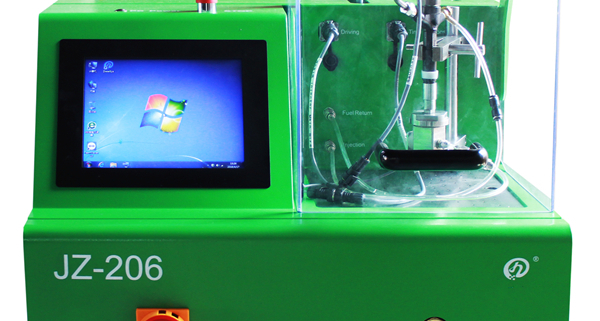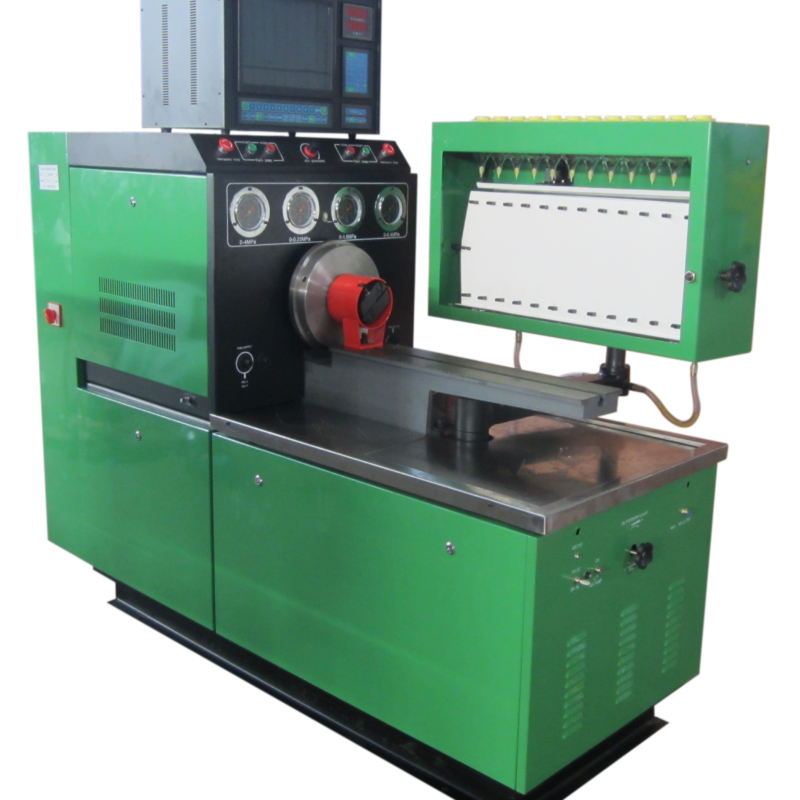Common Rail Injector Test Steps
Common rail injector test steps:
In the common rail test bench, the injector test goes by 4 or 5 steps: Leak test, VL, LL, VE, EM ,Pre-injection, some customers ask what is the meaning of this step, today we talk about these step’s meaning, and how it affects the engine’s performance
LEAK TEST: Sealing test
In this step, the control system does not trigger the injector. The pressure rises slowly from 0 bar to a maximum pressure of 1600 bar. Seeing with eyes,if the nozzle is free from dripping fuel, The injector housing has no leakage. The system simultaneously measures the static fuel return to judge if the high pressure seal ring, ball and seat damaged or not ( in this step if the nozzle dripping fuel, engine will emit black smoke, work violent, the fuel return volume bigger will cause difficult start, frequent flameout, speed limit, metering unit exceeds the maximum value)
VL: Full load fuel quantity
This step simulates the engine full-load fuel injection, and the system flow sensor accurately detects the fuel injection amount and the return amount. The displayed flow rate is the single injection value of the injector. The effect of the amount of fuel injection is the same as that of the Euro 2 system. The DNH gasket in the injector is adjusted to save fuel. The amount of fuel return is further detected whether the control valve set of the common rail injector is damaged
TL\EM Average point\Drain point\Exhaust gas limit fuel supply( all are same, just different description)
This step is similar to the torque of the traditional Euro 2 system torque point, and achieves the purpose of discharge.
If the amount of fuel is too small, the engine is weak, the speed is slow, the power is insufficient, the smoke is too large, and the emission standard is not reached. The AH, DNH, VFK, and DFK gaskets can be adjusted to obtain a satisfactory acceleration curve.
LL: Idle fuel supply
Simulate engine idling conditions, this step should ensure that the idling fuel is in the range
within the perimeter,if the consistency is not good, the speed is unstable, and it is easy to flame out and the noise is loud. Larger idling fuel quantity causes excessive speed and smoking, if small idling fuel quantity ,engine is easy to flame out, not easy to start the engine or slow down!
VE; pre-injection
Pre- injection is a small amount of fuel injected into the engine before injection.
Heat, reduce noise, better for cold start, reduce emissions, pre-injection bigger will increase noise knocking, engine blue smoke, too small will cause start difficulty, there is acceleration noise when engine acceleration , acceleration is not smooth, more violate for acceleration.
Pasos de prueba comunes del inyector del carril:
En el banco de pruebas Common Rail, la prueba del inyector pasa por 4 o 5 pasos: prueba de fugas, VL, LL, VE, EM, preinyección, algunos clientes preguntan qué significa este paso, hoy hablamos sobre el significado de estos pasos. , y como afecta el rendimiento del motor.
PRUEBA DE FUGAS: prueba de sellado
En este paso, el sistema de control no dispara el inyector. La presión aumenta lentamente desde 0 bar hasta una presión máxima de 1600 bar. Al ver con los ojos, si la boquilla no gotea combustible, la carcasa del inyector no tiene fugas. El sistema mide simultáneamente el retorno de combustible estático para determinar si el anillo de sello de alta presión, la bola y el asiento están dañados o no (en este paso, si la boquilla gotea combustible, el motor emitirá humo negro, funcionará de forma violenta, el volumen de retorno de combustible más grande causará dificultades) inicio, llama frecuente, límite de velocidad, unidad de medición excede el valor máximo)
VL: Cantidad de combustible a plena carga
Este paso simula la inyección de combustible a plena carga del motor, y el sensor de flujo del sistema detecta con precisión la cantidad de inyección de combustible y la cantidad de retorno. La tasa de flujo mostrada es el único valor de inyección del inyector. El efecto de la cantidad de inyección de combustible es el mismo que el del sistema Euro 2. La junta DNH en el inyector se ajusta para ahorrar combustible. ¡La cantidad de retorno de combustible se detecta aún más si el conjunto de válvulas de control del inyector de riel común está dañado!
TL \ EM Punto medio \ Punto de drenaje \ Límite de suministro de combustible de combustible (todos son iguales, solo descripciones diferentes)
Este paso es similar al torque del tradicional punto de torque del sistema Euro 2, y logra el propósito de la descarga.
Si la cantidad de combustible es demasiado pequeña, el motor es débil, la velocidad es lenta, la potencia es insuficiente, el humo es demasiado grande y no se alcanza el estándar de emisión. Las juntas AH, DNH, VFK y DFK se pueden ajustar para obtener una curva de aceleración satisfactoria.
LL: ¡Suministro de combustible inactivo!
Simular las condiciones de ralentí del motor, este paso debe garantizar que el combustible al ralentí esté en el rango
dentro del perímetro, si la consistencia no es buena, la velocidad es inestable, es fácil de apagar y el ruido es fuerte. La mayor cantidad de combustible al ralentí causa una excesiva velocidad y humo, si es pequeña la cantidad de combustible al ralentí, el motor es fácil de apagar, ¡no es fácil arrancar el motor o desacelerarlo
VE; pre-spray
La inyección previa es una pequeña cantidad de combustible inyectado en el motor antes de la inyección.
El calor, reducir el ruido, mejor para el arranque en frío, reducir las emisiones, pre-inyección más grande aumentará el ruido, el humo azul del motor, demasiado pequeño causará dificultades de arranque, hay un ruido de aceleración cuando la aceleración del motor, la aceleración no es suave, más se viola la aceleración .




Leave a Reply
Want to join the discussion?Feel free to contribute!